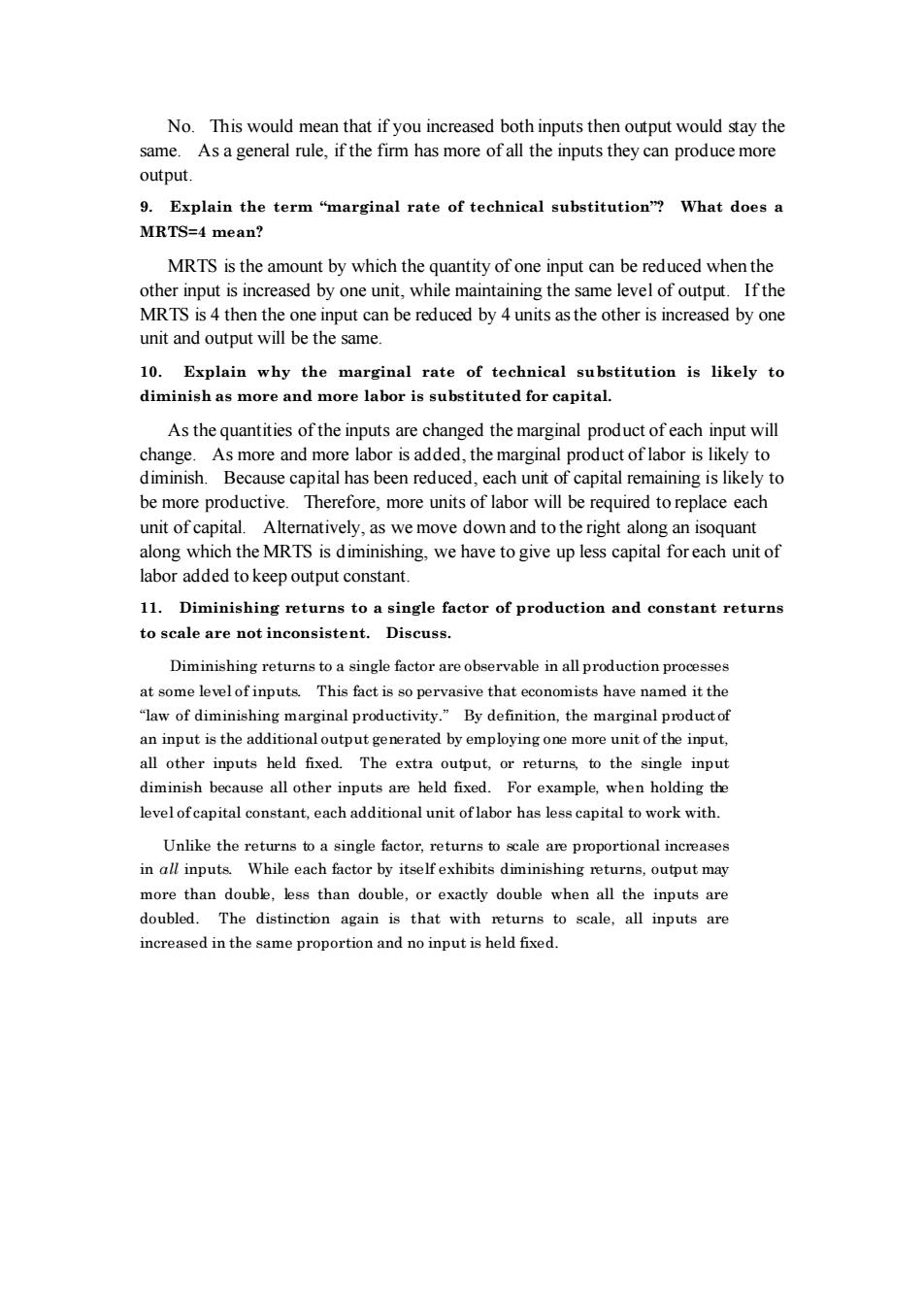正在加载图片...

No.This would mean that if you increased both inputs then ouput would stay the same. Asa general rule,if the fimm has more of all the inputs they can produce more output. 9.Explain the term"marginal rate of technical substitution"? What does a MRTS=4 mean? MRTS is the amount by which the quantity of one input can be reduced when the other input is increased by one unit,while maintaining the same level of output.If the MRTS is 4 then the one i unit and output will be beucdbysthe othersd y on 10.Explain why the marginal rate of technical substitution is likely to diminish as more and more labor is substituted for capital. As the quantities of the inputs are changed the marginal product of each input will change.As more and more labor is added,the marginal product of labor is likely to diminish.Because capital has been reduced,each unit of capital remaining is likely to be more productive.Therefore,more units of labor will be required to replace each unit of capital. Alternatively,as e move down and to the right along an isoquant along which the MRIS is diminishing.we have to give up less capital for each unit of labor added to keep output constant. 11.Diminishing returns to a single factor of production and constant returns to scale are not inconsistent.Discuss. Diminishing returns to a single factor are observable in all production processes at some This fact issope aw of dimn ervasive that economists have named it the rginal pr oduct By definition, marginal productof an input is the additional output generated by employing one more unit of the input all other inputs held fixed.The extra output,or returns,to the single input diminish because all other inputs are held fixed.For example,when holding the level ofcapital constant each additional unit oflabor has less capital to work with. Unlike the returns to a single factor,returns to scale are proportional increases in all inputs.While each facte by itself exhibits diminishing turns,output may more than doubk.than when all the imputa are doubled.The distinction again is that with returns to scale,all inputs are increased in the same proportion and no input is held fixed.No. This would mean that if you increased both inputs then output would stay the same. As a general rule, if the firm has more of all the inputs they can produce more output. 9. Explain the term “marginal rate of technical substitution”? What does a MRTS=4 mean? MRTS is the amount by which the quantity of one input can be reduced when the other input is increased by one unit, while maintaining the same level of output. If the MRTS is 4 then the one input can be reduced by 4 units as the other is increased by one unit and output will be the same. 10. Explain why the marginal rate of technical substitution is likely to diminish as more and more labor is substituted for capital. As the quantities of the inputs are changed the marginal product of each input will change. As more and more labor is added, the marginal product of labor is likely to diminish. Because capital has been reduced, each unit of capital remaining is likely to be more productive. Therefore, more units of labor will be required to replace each unit of capital. Alternatively, as we move down and to the right along an isoquant along which the MRTS is diminishing, we have to give up less capital for each unit of labor added to keep output constant. 11. Diminishing returns to a single factor of production and constant returns to scale are not inconsistent. Discuss. Diminishing returns to a single factor are observable in all production processes at some level of inputs. This fact is so pervasive that economists have named it the “law of diminishing marginal productivity.” By definition, the marginal product of an input is the additional output generated by employing one more unit of the input, all other inputs held fixed. The extra output, or returns, to the single input diminish because all other inputs are held fixed. For example, when holding the level of capital constant, each additional unit of labor has less capital to work with. Unlike the returns to a single factor, returns to scale are proportional increases in all inputs. While each factor by itself exhibits diminishing returns, output may more than double, less than double, or exactly double when all the inputs are doubled. The distinction again is that with returns to scale, all inputs are increased in the same proportion and no input is held fixed